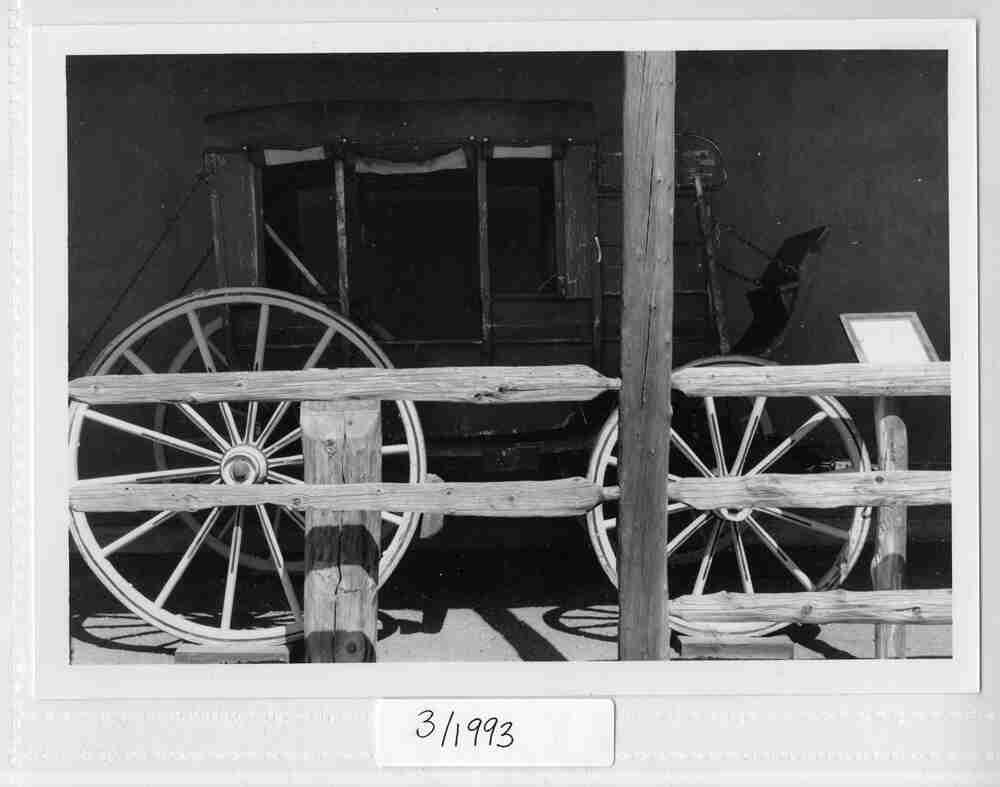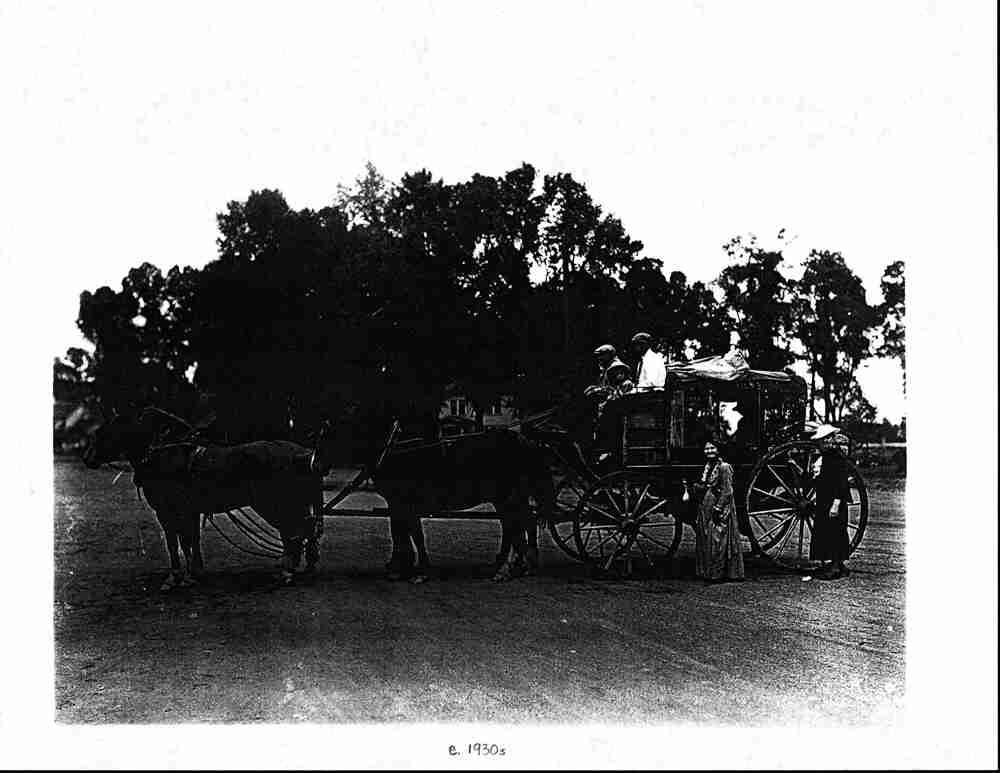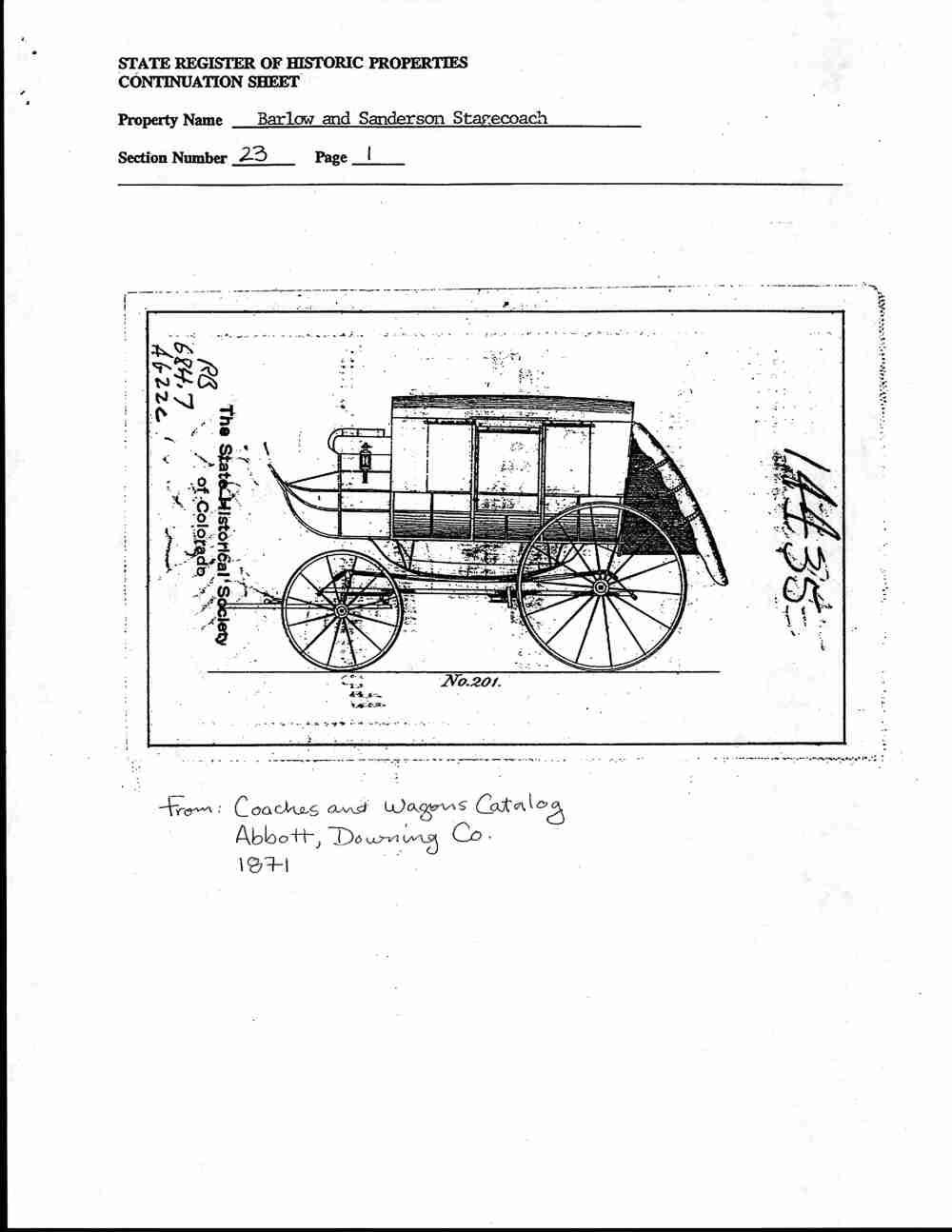Barlow and Sanderson Stagecoach
Full Article
The Barlow and Sanderson stagecoach in Monte Vista is a mud wagon like those that operated in the 1870s and 1880s along Barlow and Sanderson lines in the San Luis Valley. The only regional example of its type, the stagecoach was acquired by the Monte Vista Commercial Club and donated in 1959 to the Colorado Historical Society, which housed it for decades in the Fort Garland Museum. Because of conditions imposed on the original donation, in 2014 History Colorado (formerly the Colorado Historical Society) returned the stagecoach to Monte Vista, where it is in storage awaiting renovation and display in the Transportation of the West Museum.
Barlow and Sanderson in the San Luis Valley
Before the rapid expansion of railroads in the West in the 1870s and 1880s, stagecoaches carried passengers, mail, and freight from town to town. Bradley Barlow and Jared Sanderson first entered the stagecoach business in the early 1860s in Missouri. The first use of the Barlow, Sanderson and Company name came in 1866, by which time it had a route to California. It was the only major company operating on western mainlines aside from Wells, Fargo and Company, which had come to dominate stage lines in the West. In the early 1870s Barlow and Sanderson controlled the Southern Overland Mail and Express Company, which was the last transcontinental stage line and the last stagecoach carrier of mail to California, as well as the mail route between Denver and Santa Fe. At its height, the company reportedly had 5,000 horses and mules in constant use on stage lines in Colorado and New Mexico.
By the mid-1870s stagecoaches were becoming feeders operating at the fringes of the railroads rather than main lines of transportation. Barlow and Sanderson began to operate a network of lines linking the San Luis Valley and the San Juan Mountains to the railroads. As the Denver & Rio Grande Railroad and the Atchison, Topeka & Santa Fe Railroad moved into the San Luis Valley, the stage terminus shifted each time the railroads opened a new section of track. By the early 1880s Barlow and Sanderson was operating primarily between mining camps in the San Juan Mountains.
Barlow retired in 1878. The company continued to operate in Colorado under the name J. L. Sanderson and Company until 1884, when Sanderson sold his Colorado operations to the Colorado and Wyoming Stage, Mail and Express Company. The same coaches continued to serve the company’s stage lines, but by this time stage use in Colorado had entered a period of permanent decline.
The Stagecoach at Fort Garland
Sometime before 1947, the Monte Vista Commercial Club (predecessor of the Chamber of Commerce) bought a Barlow and Sanderson stagecoach that had been used in the San Luis Valley in the 1870s and 1880s. In 1959 the club donated the stagecoach to the Colorado Historical Society, which decided to display it at the Fort Garland Museum to illustrate the fort’s use as a stage stop. In 1962 the stagecoach was restored and painted red, the color found on the popular Concord model made by leading nineteenth-century New Hampshire–based stagecoach manufacturer Abbot, Downing and Company.
In 1993, the stagecoach was examined by Merri Ferrell, a curator and carriage expert from the Museums at Stony Brook (now the Long Island Museum of American Art, History, and Carriages). Ferrell determined that the stagecoach was made by Abbot, Downing but was not a Concord coach. Instead, the stagecoach resembles a “mud wagon” found in the 1871 Abbot, Downing catalog. This type of wagon was smaller, lighter, and lower to the ground than a Concord coach. It was used primarily on steep and rough mountain roads in the West, especially in bad weather. The original color used on mud wagons was straw yellow, not the red of Concord coaches.
In 1996, a State Historical Fund grant allowed the stagecoach to be properly restored to its original color scheme. It continued to suffer damage over the next two decades, however, because it was displayed at Fort Garland in a shed that was open to the elements.
Move to Monte Vista
When the Monte Vista Commercial Club originally donated the stagecoach to the Colorado Historical Society in 1959, the donation came with conditions, including a provision allowing Monte Vista to use the stagecoach for special events and prohibiting its removal from Fort Garland for any other reason. This meant that History Colorado could not maintain the stagecoach in accordance with professional museum standards. As a result, History Colorado officially removed the stagecoach from its holdings on July 24, 2014, and transferred custody to Monte Vista.
The stagecoach is now in storage in Monte Vista awaiting decisions about funding and renovations. The Monte Vista Historical Society hopes the stagecoach will be renovated and placed in the Transportation of the West Museum, which offers an enclosed location to protect the stagecoach and an appropriate interpretive framework for understanding its history.
10th Grade
The Barlow and Sanderson stagecoach in Monte Vista is a mud wagon like those that operated in the 1870s and 1880s along Barlow and Sanderson lines in the San Luis Valley. It is the only regional example of its type. The stagecoach was acquired by the Monte Vista Commercial Club and donated in 1959 to the Colorado Historical Society. In 2014 History Colorado returned the stagecoach to Monte Vista. It is in storage awaiting renovation and display in the Transportation of the West Museum.
Barlow and Sanderson in the San Luis Valley
Before the rapid expansion of railroads in the West in the 1870s and 1880s, stagecoaches carried passengers, mail, and freight from town to town. Bradley Barlow and Jared Sanderson first entered the stagecoach business in the early 1860s in Missouri. The first use of the Barlow, Sanderson and Company name came in 1866, by which time it had a route to California. It was the only major company operating on western mainlines aside from Wells, Fargo and Company. In the early 1870s Barlow and Sanderson controlled the Southern Overland Mail and Express Company. The company was the last transcontinental stage line and the last stagecoach carrier of mail to California. It was also the mail route between Denver and Santa Fe. At its height, the company reportedly had 5,000 horses and mules in use on lines in Colorado and New Mexico.
By the mid-1870s stagecoaches were operating at the fringes of the railroad. Barlow and Sanderson began to operate a network of lines linking the San Luis Valley and the San Juan Mountains to the railroads. The stage terminus shifted each time the railroads opened a new section of track. By the early 1880s Barlow and Sanderson was operating primarily between mining camps in the San Juan Mountains.
Barlow retired in 1878. The company continued to operate in Colorado under the name J. L. Sanderson and Company until 1884. That's when Sanderson sold his Colorado operations to the Colorado and Wyoming Stage, Mail and Express Company. The same coaches continued to serve the company’s stage lines. However, stage use in Colorado was decreasing.
The Stagecoach at Fort Garland
Sometime before 1947, the Monte Vista Commercial Club bought a Barlow and Sanderson stagecoach that had been used in the San Luis Valley in the 1870s and 1880s. In 1959 the club donated the stagecoach to the Colorado Historical Society. The Society decided to display the coach at the Fort Garland Museum to illustrate the fort’s use as a stage stop. In 1962 the stagecoach was restored and painted red. That was the color of the popular Concord model made by leading nineteenth-century stagecoach builder Abbot, Downing and Company.
In 1993, the stagecoach was examined by carriage expert Merri Ferrell. Ferrell determined that the stagecoach was made by Abbot, Downing. However, it was not a Concord coach. Instead, the stagecoach resembles a “mud wagon.” This type of wagon was smaller, lighter, and lower to the ground than a Concord coach. It was used primarily on steep and rough mountain roads in the West. The original color used on mud wagons was straw yellow, not the red of Concord coaches.
In 1996, a State Historical Fund grant allowed the stagecoach to be properly restored to its original color scheme. It suffered damage over the next two decades because it was displayed in a shed that was open to the elements.
Move to Monte Vista
When the Monte Vista Commercial Club donated the stagecoach to the Colorado Historical Society in 1959, there were conditions. These included a provision allowing Monte Vista to use the stagecoach for special events and prohibiting its removal from Fort Garland for any other reason. This meant that History Colorado could not maintain the stagecoach in accordance with museum standards. As a result, History Colorado officially removed the stagecoach from its holdings on July 24, 2014. It was transferred to Monte Vista.
The stagecoach is now in storage in Monte Vista awaiting decisions about funding and renovations. The Monte Vista Historical Society hopes the stagecoach will be renovated and placed in the Transportation of the West Museum. The museum offers an enclosed location to protect the stagecoach and an appropriate interpretive framework for understanding its history.
8th Grade
The Barlow and Sanderson stagecoach in Monte Vista is a mud wagon. It is the only regional example of its kind.
Barlow and Sanderson in the San Luis Valley
Before railroads came to the West in the 1870s and 1880s, stagecoaches carried passengers, mail, and freight from town to town. Bradley Barlow and Jared Sanderson first entered the stagecoach business in the early 1860s in Missouri. The first use of the Barlow, Sanderson and Company name came in 1866. It was the only major company operating on western mainlines besides Wells, Fargo and Company. In the early 1870s Barlow and Sanderson controlled the Southern Overland Mail and Express Company. The company was the last transcontinental stage line and the last stagecoach carrier of mail to California. It was also the mail route between Denver and Santa Fe. At its height, the company had 5,000 horses and mules in use on lines in Colorado and New Mexico.
By the mid-1870s stagecoaches were operating at the edges of the railroad. Barlow and Sanderson began linking the San Luis Valley and the San Juan Mountains to the railroads. The end of the line shifted when railroads opened a new section of track. By the early 1880s Barlow and Sanderson was operating mostly between mining camps in the San Juan Mountains.
Barlow retired in 1878. The company continued to operate in Colorado under the name J. L. Sanderson and Company until 1884. That's when Sanderson sold his Colorado operations.
The Stagecoach at Fort Garland
Sometime before 1947, the Monte Vista Commercial Club bought a Barlow and Sanderson stagecoach. The coach had been used in the San Luis Valley in the 1870s and 1880s. In 1959 the club donated the stagecoach to the Colorado Historical Society. The Society decided to display the coach at the Fort Garland Museum to illustrate the fort’s use as a stage stop. In 1962 the stagecoach was painted red. That was the color of the popular Concord model made by leading stagecoach builder Abbot, Downing and Company.
In 1993, the stagecoach was examined by carriage expert Merri Ferrell. Ferrell determined that the stagecoach was made by Abbot, Downing. However, it was not a Concord coach. Instead, the stagecoach resembles a “mud wagon.” This type of wagon was smaller and lower to the ground than a Concord coach. It was used on steep mountain roads in the West. The original color used on mud wagons was straw yellow, not the red of Concord coaches.
In 1996, a State Historical Fund grant allowed the stagecoach to be restored to its original color. However, it suffered damage over the next two decades because it was displayed in a shed that was open to the elements.
Move to Monte Vista
When the Monte Vista Commercial Club donated the stagecoach to the Colorado Historical Society in 1959, there were conditions. Monte Vista could use the stagecoach for special events. The coach could not be removed from Fort Garland for any other reason. This meant that History Colorado could not maintain the stagecoach to museum standards. As a result, History Colorado removed the stagecoach from its holdings on July 24, 2014. It was transferred to Monte Vista.
The stagecoach is now in storage in Monte Vista. The Monte Vista Historical Society hopes the stagecoach will be renovated and placed in the Transportation of the West Museum. The museum offers an enclosed location to protect the stagecoach.
4th Grade
The Barlow and Sanderson stagecoach in Monte Vista is a mud wagon. It is the only regional example of its kind.
Barlow and Sanderson in the San Luis Valley
Before railroads came to the West in the 1870s and 1880s, stagecoaches carried people and mail from town to town. Bradley Barlow and Jared Sanderson entered the stagecoach business in the early 1860s. The first use of the Barlow, Sanderson and Company name was in 1866. It was the only major company operating out west besides Wells, Fargo and Company. In the early 1870s Barlow and Sanderson controlled the Southern Overland Mail and Express Company. The company was the last transcontinental stage line. It was also the mail route between Denver and Santa Fe. At its height, the company had 5,000 horses and mules in use in Colorado and New Mexico.
By the mid-1870s stagecoaches were operating at the edges of the railroad. Barlow and Sanderson began linking the San Luis Valley and the San Juan Mountains to the railroads. The end of their service shifted when railroads opened a new section of track. By the early 1880s Barlow and Sanderson was operating mostly between mining camps in the San Juan Mountains.
Barlow retired in 1878. The company continued to operate in Colorado until 1884. That's when Sanderson sold his Colorado operations.
The Stagecoach at Fort Garland
Sometime before 1947, the Monte Vista Commercial Club bought a Barlow and Sanderson stagecoach. The coach had been used in the San Luis Valley in the 1870s and 1880s. In 1959 the club donated the stagecoach to the Colorado Historical Society. The Society decided to display the coach at the Fort Garland Museum. They wanted to show the fort’s use as a stage stop. In 1962 the stagecoach was painted red. That was the color of the popular Concord model made by stagecoach builder Abbot, Downing and Company.
In 1993, the stagecoach was looked at by a carriage expert. The expert said that the stagecoach was not a Concord coach. Instead, it was a “mud wagon.” This type of wagon was smaller and lower to the ground. It was used on steep mountain roads in the West. The original color used on mud wagons was straw yellow, not red.
In 1996, the stagecoach was repainted its original color. However, it was damaged because it was displayed in a shed that was open to the elements.
Move to Monte Vista
When the stagecoach was donated, there were conditions. Monte Vista could use the stagecoach for special events. The coach could not be removed from Fort Garland for any other reason. This meant that the stagecoach could not be maintained to museum standards. As a result, the stagecoach was moved to Monte Vista.
The stagecoach is now in storage in Monte Vista in hopes it can be placed in the Transportation of the West Museum. The museum can protect the stagecoach.




































